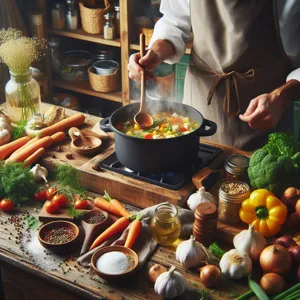In the quest for healthier living, the oils we choose for cooking can make a significant difference in our overall well-being.
With a plethora of options lining supermarket shelves—from olive oil and avocado oil to coconut oil and canola oil—deciding which cooking oils to incorporate into your kitchen can be overwhelming. Each type of oil comes with its unique set of flavors, cooking properties, and health benefits, making it essential to understand their distinct characteristics. In this ultimate guide, we will demystify the world of cooking oils, diving into the healthiest options available, their nutritional profiles, and the best culinary uses for each. Whether you’re sautéing vegetables, baking a delectable dish, or dressing a fresh salad, this comprehensive resource will empower you to make informed choices that not only enhance your meals but also support a healthier lifestyle. Join us as we explore the rich, flavorful world of cooking oils and discover which ones truly deserve a place in your pantry.
1. Introduction to Cooking Oils: Why They Matter

Cooking oils are more than just a medium for frying or sautéing; they are an essential component of our culinary practices and play a significant role in our overall health. The types of oil we choose can affect not only the flavor and texture of our dishes but also our nutritional intake and long-term well-being. With the vast array of oils available on grocery store shelves—from the familiar olive and canola to the more exotic avocado and coconut—it’s crucial to understand the properties and benefits of each.
At their core, cooking oils are fats that provide energy and help our bodies absorb essential vitamins. They can be classified into two main categories: saturated and unsaturated fats. Unsaturated fats, often found in plant-based oils, are known for their heart-health benefits, while saturated fats, predominantly found in animal fats and certain tropical oils, should be consumed in moderation.
The smoke point of an oil—the temperature at which it begins to smoke and break down—also plays a crucial role in cooking. Using an oil beyond its smoke point can lead to the formation of harmful compounds and an unpleasant taste, making it vital to choose the right oil for the method of cooking, whether you’re frying, baking, or dressing a salad.
Moreover, the right cooking oil can enhance the nutritional profile of your meals. For instance, oils rich in omega-3 fatty acids, such as flaxseed oil, can support heart health, while oils packed with antioxidants, like extra virgin olive oil, can combat inflammation and improve overall health.
In this guide, we will explore various cooking oils, detailing their health benefits, ideal cooking methods, and tips on how to incorporate them into your daily meals. By the end, you’ll not only have a clearer understanding of the healthiest cooking oils available but also feel empowered to make informed choices that will enhance both your culinary creations and your well-being.
2. Understanding Smoke Points: What You Need to Know
When it comes to cooking oils, understanding smoke points is crucial for both health and flavor. The smoke point is the temperature at which an oil begins to break down and produce smoke, releasing harmful compounds and imparting a burnt taste to your dishes. Using oils past their smoke point can not only ruin the flavor of your food but also lead to the formation of free radicals, which may have negative health effects.
Different oils have different smoke points, so it’s essential to choose the right one for your cooking method. For example, oils with high smoke points, like avocado oil (around 520°F or 271°C) and refined grapeseed oil (approximately 420°F or 216°C), are excellent choices for high-heat cooking methods such as frying and searing. These oils can withstand intense temperatures without breaking down, allowing you to achieve that perfect golden-brown crust without compromising the health benefits.
On the other hand, oils with lower smoke points, such as extra virgin olive oil (around 375°F or 191°C) and flaxseed oil (approximately 225°F or 107°C), are better suited for dressings, dips, or low-heat cooking. Using them at high temperatures can not only lead to a less-than-ideal flavor but may also diminish their nutritional value.
In addition to temperature considerations, it’s important to remember that the freshness of your cooking oils can also affect their smoke points. Oils that have been sitting on the shelf for too long may oxidize and have lower smoke points, so always check the expiration date and store them in a cool, dark place to preserve their quality. Understanding smoke points helps you not only cook better but also make the healthiest choices in your culinary adventures. By selecting oils thoughtfully based on their smoke points, you can elevate your dishes while maintaining optimal health.
3. The Health Benefits of Using Quality Cooking Oils

When it comes to cooking oils, the quality you choose can significantly impact not only the flavor of your dishes but also your overall health. Quality cooking oils are rich in essential nutrients and beneficial compounds that can enhance your diet and promote wellness.
Firstly, many high-quality oils, such as extra virgin olive oil, avocado oil, and flaxseed oil, are packed with monounsaturated fats. These heart-healthy fats help lower bad cholesterol levels and reduce the risk of heart disease. Olive oil, in particular, is renowned for its anti-inflammatory properties, thanks to its high content of antioxidants like oleocanthal, which can mimic the effects of ibuprofen in reducing inflammation.
Moreover, some oils are excellent sources of omega-3 fatty acids, which are crucial for brain health and reducing inflammation throughout the body. Flaxseed oil and walnut oil are particularly rich in these fatty acids, making them excellent choices for salads and cold dishes, where their delicate flavors can shine without the need for heat.
In addition to these fats, quality oils often contain vitamins and phytonutrients that contribute to overall health. For instance, avocado oil is not only flavorful but also loaded with vitamin E, which is known for its skin-protective properties and its role as a powerful antioxidant that combats free radicals in the body.
Lastly, using quality cooking oils can enhance the absorption of fat-soluble vitamins (A, D, E, and K) from the foods you consume. This means that drizzling a good-quality oil over a salad or incorporating it into your cooking can help your body absorb these essential nutrients more effectively.
Incorporating high-quality cooking oils into your daily meal prep is a simple way to elevate not just the taste of your meals but also your nutritional intake. By choosing oils that are minimally processed and rich in beneficial compounds, you can reap the health benefits while savoring the flavors they bring to your dishes.
4. Olive Oil: A Mediterranean Staple
Olive oil has long been celebrated as a cornerstone of the Mediterranean diet, renowned not only for its rich flavor but also for its myriad health benefits. Pressed from the fruit of the olive tree, this golden liquid is a staple in kitchens around the world, and for good reason. Its versatility makes it an excellent choice for sautéing vegetables, drizzling over salads, or dipping with fresh bread.
At the heart of olive oil’s appeal is its high content of monounsaturated fats, which have been linked to a reduced risk of heart disease. This oil is also packed with antioxidants, particularly vitamin E and polyphenols, which help combat oxidative stress and inflammation in the body. Research suggests that regular consumption of olive oil can contribute to improved cholesterol levels and better overall cardiovascular health.
When selecting olive oil, quality matters. Extra virgin olive oil is the highest grade available, made from the first cold pressing of olives and characterized by its superior flavor and lower acidity. Look for labels that indicate “first cold pressed” and check for certifications that ensure authenticity and quality. The flavor can vary significantly depending on the type of olives used and the region in which they are grown, ranging from buttery and mild to peppery and robust.
To fully enjoy the health benefits of olive oil, consider incorporating it into your daily cooking. Use it as a base for salad dressings, a finishing touch on roasted vegetables, or even as a flavor enhancer for soups and stews. But remember, while olive oil is healthy, it’s still calorie-dense, so moderation is key.
In summary, olive oil isn’t just a cooking fat; it’s a health-boosting powerhouse that deserves a prominent place in your pantry. Embrace this Mediterranean staple, and savor the flavor and wellness benefits it brings to your meals.
5. Avocado Oil: Nutrient-Rich and Versatile

### 5. Avocado Oil: Nutrient-Rich and Versatile
When it comes to cooking oils, few can rival the impressive nutrient profile and versatility of avocado oil. Extracted from the flesh of ripe avocados, this oil is celebrated not just for its rich, buttery flavor but also for its numerous health benefits. With a high smoke point of around 520°F (271°C), avocado oil is perfect for a variety of cooking methods, from sautéing and frying to roasting and grilling, making it a kitchen staple for health-conscious chefs.
Rich in monounsaturated fats, particularly oleic acid, avocado oil supports heart health by promoting healthy cholesterol levels. Additionally, it boasts a wealth of essential vitamins, including E, D, and K, which are known for their antioxidant properties and role in maintaining healthy skin. This makes it an excellent choice not only for cooking but also for drizzling over salads or using as a dip for fresh bread.
One of the standout features of avocado oil is its versatility in flavor profiles. Its mild yet distinct taste complements both savory and sweet dishes, allowing it to shine in everything from creamy dressings to baked goods. Furthermore, avocado oil is a fantastic carrier for herbs and spices, enhancing the overall flavor of your meals while adding a nutritional punch.
Beyond the kitchen, avocado oil is increasingly finding its way into beauty regimens, thanks to its moisturizing properties. Used as a natural moisturizer, it can hydrate skin and hair, making it a valuable addition to your personal care routine.
Incorporating avocado oil into your diet not only aligns with a healthy lifestyle but also opens up a world of culinary creativity. Whether you’re drizzling it over a vibrant salad, using it as a base for marinades, or simply enjoying it as an everyday cooking oil, avocado oil is truly a superstar in the realm of healthy cooking fats. Embrace its richness and versatility, and watch as your meals transform into nutritious and delicious experiences.
6. Coconut Oil: Myths and Facts
Coconut oil has gained immense popularity in recent years, often touted as a superfood that can revolutionize your cooking and health. However, alongside its rise to fame, a plethora of myths and misconceptions have emerged, creating a cloud of confusion for consumers. In this section, we’ll sift through the noise to uncover the facts about coconut oil, helping you make informed decisions for your kitchen.
First and foremost, let’s address the myth that coconut oil is a miracle cure-all. While it does offer certain health benefits, such as antimicrobial properties and the potential to boost heart health when used in moderation, it’s essential to recognize that it is still a saturated fat. In fact, about 90% of the fat in coconut oil is saturated, which can raise LDL cholesterol levels if consumed in excess. This doesn’t mean you should eliminate it from your diet entirely, but rather use it thoughtfully, balancing it with healthier unsaturated oils like olive or avocado oil.
Another common belief is that coconut oil is the best choice for high-heat cooking. While it does have a relatively high smoke point (around 350°F or 177°C), it’s not the only option. Olive oil, for instance, has a smoke point of about 375-405°F (190-207°C) and is rich in heart-healthy monounsaturated fats, making it an excellent alternative for sautéing and roasting.
Coconut oil also boasts a unique flavor profile, lending a subtle sweetness to dishes, which can enhance certain recipes—think tropical curries or baked goods. However, this distinct taste isn’t universally loved; it can overpower more delicate flavors. Thus, it’s essential to consider the culinary context when using coconut oil.
Incorporating coconut oil into your diet can certainly have its place, especially in moderation and as part of a varied cooking repertoire. Whether you’re using it for frying, baking, or even as a natural moisturizer or hair conditioner, understanding the facts behind coconut oil ensures you reap its benefits without falling prey to its myths. Embrace coconut oil thoughtfully, and it can be a valuable addition to your cooking oil collection.
7. Canola Oil: Is it a Healthy Option?

Canola oil has long been a staple in kitchens around the world, celebrated for its versatility and mild flavor. Extracted from the seeds of the canola plant, this oil is often touted as a heart-healthy option due to its favorable fatty acid profile. Comprising a high percentage of monounsaturated fats, canola oil is known to help reduce bad cholesterol levels when used in moderation, potentially lowering the risk of heart disease.
However, the health attributes of canola oil are a topic of much debate. While its low saturated fat content makes it an appealing choice, the majority of canola oil on the market today is refined and often derived from genetically modified crops. This raises concerns for those cautious about GMOs or looking to avoid highly processed oils. Moreover, many brands use chemical solvents during extraction, which can lead to the presence of trace residues in the final product.
When considering canola oil as a cooking option, it’s essential to look for cold-pressed or organic varieties, which tend to retain more nutrients and minimize the presence of harmful chemicals. Additionally, canola oil has a relatively high smoke point, making it suitable for various cooking methods, from sautéing to baking.
In summary, while canola oil can be part of a healthy diet, it’s crucial to choose high-quality options and consume it in moderation. Balancing canola oil with other cooking oils, like olive or avocado oil, can offer a more diverse range of nutrients and flavors, ensuring that your culinary adventures are both delicious and health-conscious.
8. Grapeseed Oil: Pros and Cons
### Grapeseed Oil: Pros and Cons
Grapeseed oil, derived from the seeds of grapes—often a byproduct of winemaking—has gained popularity as a versatile cooking oil in recent years. Its light flavor and high smoke point make it an appealing choice for various culinary applications, from sautéing and frying to salad dressings and marinades. However, like any cooking oil, grapeseed oil has its pros and cons, and understanding them can help you make informed choices for your health and cooking needs.
**Pros:**
1. **High Smoke Point:** Grapeseed oil boasts a smoke point of around 420°F (216°C), making it suitable for high-heat cooking methods like frying and searing. This high tolerance means you can create crispy, golden-brown dishes without the worry of burning the oil.
2. **Rich in Polyunsaturated Fats:** Grapeseed oil is predominantly composed of polyunsaturated fats, particularly omega-6 fatty acids, which play a crucial role in cell structure and overall health when consumed in moderation.
3. **Vitamin E Content:** This oil is a good source of vitamin E, a powerful antioxidant that helps protect cells from damage caused by free radicals. This nutrient can also support skin health and improve immune function.
4. **Mild Flavor:** With its subtle, neutral taste, grapeseed oil enhances the flavors of your dishes without overpowering them. This makes it an excellent choice for salad dressings, marinades, and delicate sauces.
**Cons:**
1. **High in Omega-6 Fatty Acids:** While omega-6 fatty acids are essential for health, the typical Western diet is already rich in these fats. Overconsumption of omega-6s, especially without a balanced intake of omega-3 fatty acids, can lead to inflammation and health issues. It’s crucial to use grapeseed oil in moderation and balance it with omega-3 sources like flaxseed or fish oils.
2. **Refined Oil:** Most commercially available grapeseed oils are refined, which can strip away some of the beneficial nutrients and antioxidants. Choosing cold-pressed or minimally processed options can help retain more of their natural benefits.
3. **Potential Allergens:** For those with grape allergies, grapeseed oil may pose a risk, as it could potentially trigger allergic reactions. Always be cautious and check with a healthcare provider if you have food allergies.
4. **Sustainability Concerns:** The production of grapeseed oil can raise sustainability issues, particularly if it is sourced from conventionally grown grapes that may have been treated with pesticides. Opting for organic grapeseed oil can help mitigate this concern.
In conclusion, grapeseed oil can be a valuable addition to your cooking repertoire, offering both versatility and health benefits. However, it’s important to be mindful of its omega-6 content and sourcing practices. By using grapeseed oil wisely and in conjunction with other healthy fats, you can create delicious meals while supporting your overall well-being.
9. Peanut Oil: Flavor and Health Considerations
Peanut oil is a versatile cooking oil that has gained popularity not just for its high smoke point, but also for its unique flavor profile that can elevate a variety of dishes. With a nutty taste that complements stir-fries, sautés, and marinades, it’s a staple in many Asian cuisines and can bring a delightful richness to your favorite recipes.
From a health perspective, peanut oil boasts a favorable balance of fatty acids, primarily composed of monounsaturated fats, which are known to support heart health by helping to lower bad cholesterol levels. Additionally, peanut oil contains vitamin E, an antioxidant that can help protect your cells from oxidative stress. However, it’s important to consider that peanut oil is relatively high in omega-6 fatty acids, which, when consumed in excess, may contribute to inflammation if not balanced with omega-3 intake.
Another crucial consideration is allergies; peanut oil can trigger severe allergic reactions in sensitive individuals. While refined peanut oil is often considered safe for those with allergies, due to the high levels of processing that remove many of the allergenic proteins, it’s always best to err on the side of caution and consult with a healthcare provider if you have any concerns.
When using peanut oil in your cooking, opt for high-quality, cold-pressed versions when possible to maximize health benefits while enjoying its rich, nutty flavor. Whether you’re frying up a fresh batch of spring rolls or drizzling it over a vibrant salad, peanut oil can be a delicious and health-conscious addition to your culinary repertoire. Just remember to use it in moderation and as part of a balanced diet to fully reap its benefits.
10. Flaxseed Oil: Omega-3 Powerhouse
Flaxseed oil, often hailed as an Omega-3 powerhouse, is a nutritional gem that deserves a prominent place in your kitchen. Extracted from the tiny, nutrient-dense flaxseeds, this oil is packed with alpha-linolenic acid (ALA), a type of plant-based omega-3 fatty acid that offers a multitude of health benefits. Its impressive omega-3 content is known to support heart health, reduce inflammation, and even enhance skin vitality.
One of the most remarkable features of flaxseed oil is its delicate, nutty flavor, which can elevate a variety of dishes. It’s particularly delightful in salad dressings, where its rich taste can complement the freshness of greens and vegetables. Drizzle it over roasted vegetables or mix it into smoothies for a nutritional boost without overpowering the other ingredients. However, due to its low smoke point, it is best used unheated, making it perfect for cold dishes or as a finishing oil.
In addition to its culinary uses, flaxseed oil is also a fantastic source of lignans, a type of antioxidant that may contribute to hormonal balance and overall wellness. Incorporating this oil into your diet can be an excellent way to enhance your intake of essential fatty acids, especially if you follow a vegetarian or vegan lifestyle.
When purchasing flaxseed oil, look for cold-pressed, organic varieties stored in dark bottles to preserve its freshness and potency. Keep it refrigerated to prevent oxidation, as this oil is sensitive to heat and light. With its impressive health benefits and versatile applications, flaxseed oil is a simple yet powerful addition to your pantry, paving the way for healthier cooking and eating habits.
11. Sesame Oil: Nutritional Benefits and Uses
Sesame oil, a staple in many Asian cuisines, is not just prized for its distinctive nutty flavor but also for an impressive array of nutritional benefits. Extracted from sesame seeds, this oil is rich in polyunsaturated and monounsaturated fats, making it a heart-healthy choice. It boasts a high smoke point, around 410°F (210°C), which means it’s ideal for high-heat cooking methods like stir-frying and sautéing without breaking down and losing its beneficial properties.
One of the standout features of sesame oil is its wealth of antioxidants, particularly sesamol and sesamin, which have been shown to combat oxidative stress in the body. These powerful compounds may help reduce inflammation and lower the risk of chronic diseases such as heart disease and diabetes. Additionally, sesame oil contains a healthy dose of vitamin E and other essential nutrients, contributing to skin health and overall well-being.
In the kitchen, sesame oil is incredibly versatile. It can be used as a cooking oil, drizzled over salads for added flavor, or blended into marinades and dressings. Its robust flavor complements a variety of dishes, from Asian stir-fries and noodle soups to roasted vegetables and grilled meats. For those seeking to enhance their culinary repertoire, a touch of toasted sesame oil can elevate dishes with its rich, aromatic profile, imparting a depth of flavor that is hard to match.
Incorporating sesame oil into your diet is as simple as adding a splash to your next stir-fry or using it to enhance the flavor of your favorite dipping sauces. However, moderation is key, as with any oil. By choosing high-quality, cold-pressed sesame oil, you can ensure you’re getting the maximum health benefits while enjoying its delightful taste.
12. Comparing Oils: Fats, Flavor, and Functionality
When it comes to choosing the right cooking oil, understanding the nuances of fats, flavor, and functionality is essential. Each oil possesses a unique composition of fatty acids, which not only affects its health benefits but also its cooking properties and the overall taste it imparts to your dishes.
Starting with fats, oils can be broadly categorized into saturated, monounsaturated, and polyunsaturated fats. Saturated fats, found in oils like coconut and palm, tend to be solid at room temperature and can withstand high heat, making them ideal for frying. However, moderation is key, as excessive intake can raise cholesterol levels. On the other hand, oils rich in monounsaturated fats, such as olive and avocado oil, are celebrated for their heart-healthy benefits. They add a rich, buttery flavor to salads and roasted vegetables, enhancing dishes without overpowering them.
Polyunsaturated fats, including those found in canola and sunflower oil, are versatile and often used for baking or sautéing due to their high smoke points. These oils can be beneficial for heart health when used in moderation, but it’s essential to balance them with oils that have higher omega-3 fatty acids, like flaxseed or walnut oil, which are known for their anti-inflammatory properties.
Flavor is another critical aspect of oil selection. Some oils, like extra virgin olive oil, have a robust, fruity flavor that can elevate a simple dish, while others, like grapeseed oil, are more neutral and unobtrusive. When selecting an oil, consider how it will complement the ingredients in your recipe. For example, a delicate fish dish might be best paired with a light oil, whereas a hearty vegetable stir-fry could benefit from the richness of sesame oil.
Functionality is where your cooking needs come into play. Are you frying, sautéing, baking, or dressing? Each cooking method may require a different oil, based on its smoke point—the temperature at which an oil begins to smoke and break down. Oils with high smoke points, such as avocado and peanut oil, are perfect for high-heat cooking methods, while oils with lower smoke points, like flaxseed and pumpkin seed oil, are best used in dressings or drizzled over finished dishes to preserve their nutrients.
Ultimately, the key to mastering the art of cooking oils lies in understanding these three facets: fats, flavor, and functionality. By selecting the right oil for each culinary application, you can enhance the taste of your meals while also making healthier choices. So, next time you’re reaching for a bottle, consider what you’re cooking and how the oil can elevate your dish to new heights.
13. How to Choose the Right Oil for Different Cooking Methods
Choosing the right oil for various cooking methods is crucial not only for enhancing the flavor of your dishes but also for maximizing the health benefits of your meals. Different cooking techniques require oils with distinct characteristics, such as smoke points, flavor profiles, and nutritional content. Here’s a breakdown of how to select the best oil for your culinary needs.
**1. High-Heat Cooking (Searing, Stir-Frying, Deep-Frying):** When cooking at high temperatures, you need oils with high smoke points to prevent burning and the formation of harmful compounds. Oils like avocado oil, grapeseed oil, and peanut oil are excellent choices due to their stability under heat. Avocado oil, in particular, boasts a smoke point of around 520°F (271°C) and is rich in heart-healthy monounsaturated fats.
**2. Medium-Heat Cooking (Sautéing, Pan-Frying):** For methods that require moderate heat, oils like olive oil and canola oil work well. Extra virgin olive oil, with its robust flavor and rich antioxidants, is perfect for sautéing vegetables or cooking proteins. It has a smoke point of around 375°F (191°C), making it suitable for medium-heat applications while retaining its nutritional benefits.
**3. Low-Heat Cooking (Baking, Roasting):** When baking or roasting, you can opt for oils that may not have the highest smoke points but offer great flavor. Coconut oil and butter can enrich baked goods with a delightful taste and aroma. Coconut oil, with its unique profile, works well in various baked items, while butter adds a rich, creamy texture.
**4. Dressings and Finishing Oils:** When it comes to salads or finishing a dish, use oils that are flavorful and packed with nutrients. Oils like flaxseed oil, walnut oil, and sesame oil not only enhance taste but also offer a wealth of omega-3 fatty acids and antioxidants. These oils should not be heated, making them perfect for drizzling over dishes or incorporating into dressings for an extra layer of flavor.
**5. Specialty Oils:** Don’t overlook the unique profiles of specialty oils like truffle oil or chili oil. These oils can elevate your dishes with their distinct flavors. Use truffle oil sparingly as a finishing touch, while chili oil can add a spicy kick to stir-fries or marinades.
By understanding the properties of various cooking oils and their compatibility with different cooking methods, you can elevate your culinary creations while making health-conscious choices. Remember, the right oil not only enhances the taste of your meals but also contributes to a balanced diet. So, next time you reach for an oil, consider how it complements your cooking technique and the dish you’re preparing for a healthier and more delicious outcome.
14. Storage Tips for Keeping Cooking Oils Fresh
When it comes to cooking oils, proper storage is essential for maintaining their freshness and ensuring that you reap the full benefits of their nutritional value. Over time, exposure to light, heat, and air can lead to oxidation, resulting in rancidity and a decline in flavor and health benefits. Here are some practical storage tips to help keep your cooking oils fresh for longer.
First and foremost, choose the right container. glass bottles are the best option for storing cooking oils, as they are non-reactive and provide a barrier against environmental factors. If possible, opt for dark-colored glass, which helps to block out light, further protecting the oil from degradation. If you’re using plastic containers, ensure they are made from BPA-free materials and are specifically designed for oil storage.
Temperature plays a crucial role in oil preservation. Store your oils in a cool, dark place, away from heat sources such as stoves, ovens, or direct sunlight. A pantry or cupboard is ideal. For oils with a shorter shelf life, such as nut oils or oils infused with herbs, refrigeration can extend their freshness significantly. Just be mindful that some oils may become cloudy when chilled, but this won’t affect their quality.
Always be sure to tightly seal your oil containers after each use to minimize air exposure. If the original cap isn’t secure, consider transferring the oil to a pump bottle or a pour spout that has a tighter seal. Additionally, keeping oils away from strong-smelling substances can prevent them from absorbing unwanted flavors and aromas.
Lastly, be proactive about labeling your oils with the purchase date. Most cooking oils have a shelf life of about six months to a year, depending on the type. Regularly check for any off smells or unusual changes in appearance, which can indicate that the oil has gone bad. By implementing these storage tips, you can keep your cooking oils fresh and flavorful, enhancing your culinary creations while maximizing their health benefits.
15. Conclusion: Making Informed Choices for Your Cooking Oils
In conclusion, making informed choices for your cooking oils is essential for not only enhancing the flavors of your dishes but also for promoting your overall health. As we’ve explored throughout this guide, the variety of oils available can be overwhelming, each with its unique properties, smoke points, and health benefits. Understanding these factors empowers you to select the oil that best suits your cooking needs and dietary preferences.
Whether you prefer the rich, nutty flavor of sesame oil for your stir-fries, the light and fruity notes of extra virgin olive oil for your salads, or the high heat tolerance of avocado oil for frying, each option brings its own set of nutrients and potential health benefits. Prioritizing oils rich in monounsaturated fats and omega-3 fatty acids can contribute to heart health, while minimizing highly processed and saturated fats can lead to a more balanced diet.
As you navigate the grocery aisles, remember to read labels carefully, opting for cold-pressed or minimally processed oils whenever possible. Experimenting with different oils in your cooking can also add a new dimension to your culinary creations, allowing you to discover flavors and textures you may not have encountered before.
Ultimately, the key takeaway is to approach your cooking oil choices with mindfulness. By selecting quality oils and using them in moderation, you can elevate your meals while supporting your long-term health. So, the next time you reach for a bottle in your pantry, take a moment to consider its benefits and how it fits into your overall cooking strategy. Your body and taste buds will thank you!




































